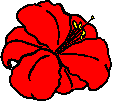 Shields
Gardens
Ltd.
Shields
Gardens
Ltd.| Home |
| Daylilies |
| Rare Bulbs |
| Clivia |
| Seed Sales |
| E-Mail and Chat |
| Photo Gallery |
| Information |
| Sources |
| Guest Sites |
| Societies and Clubs |
| Links |
| People |
| About Us |
It seems very likely that the Type 2 yellow mutation is not only at a different locus from the Type 1, but that it is qualitatively a different type of gene entirely. Some Type 2 yellows develop orange spots when the petals are wounded, almost as if they were bleeding. This orange coloration is probably due to anthocyanin formation, which seems to be completely blocked in the Type 1 yellows.
Anthocyanins are produced in many plants, including most Amaryllidaceae, in response to excess light levels. That is, they are a response to certain types of stress. Most stress reactions in plants are mediated by the plant hormone abscisic acid (ABA). Plants which go dormant in response to heat, drought, or cold stress have this response triggered by ABA. The ABA in turn was released by some system that was sensitive to the particular stress. I'll come back to this in a bit.
Since certain Type 2 yellows produce some anthocyanins in response to physical damage to floral parts, it is clear that the genes for the biosynthetic enzymes of the anthocyanin pathway are intact and functional. Since the anthocyanin pigments are still not being expressed in the normal healthy Type 2 yellow flowers, they are being shut down by regulatory genes.
I surmise that physical damage is triggering some of the ABA stress responses, one of which is apparently to release the inhibition of anthocyanin biosynthesis in the vicinity of the wound.
Since others have reported that some peaches are also in group 2, and they appear to have some anthocyanin synthesis in their undamaged flowers, the regulatory controls seem to function differently in the two types of group 2 mutants.
Some have also reported that other type 2 yellows do not produce any anthocyanins at sites of physical damage in the petals, so we appear to have at least three different types of mutations in group 2 clivias.
The situation is far from clear to me, and I think it would make a lovely PhD thesis project for some plant physiology/molecular genetics graduate student somewhere in the world. I postulate that there is perhaps a single regulatory locus in the clivia genome that has 4 different allelic forms:
Of course, it doesn't have to be this simple!
Jim Shields
| Tel: 1-317-867-3344 | ||
For information about this account, contact:
James E. Shields, webmaster
31 March 2011
© Copyright 2011 by SHIELDS GARDENS LTD. All rights reserved.